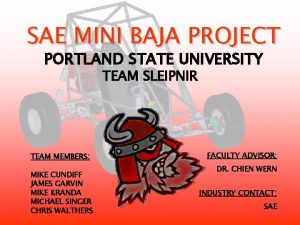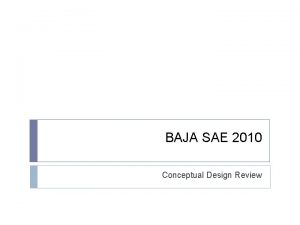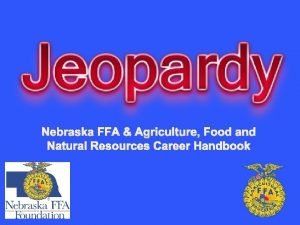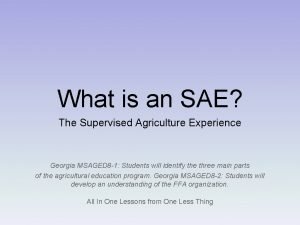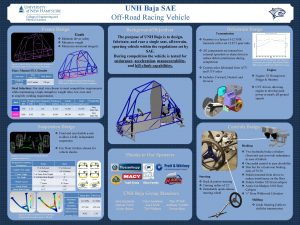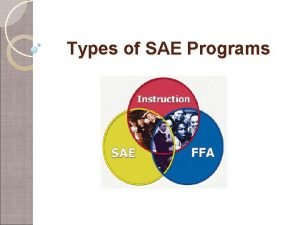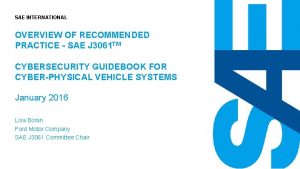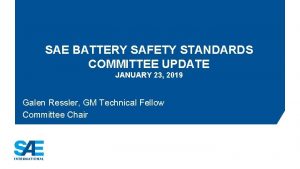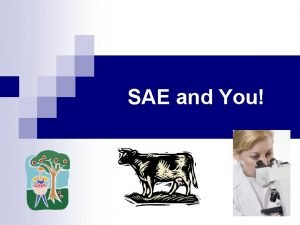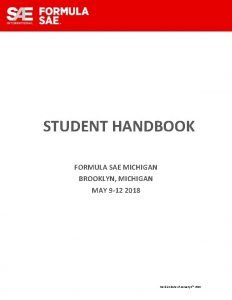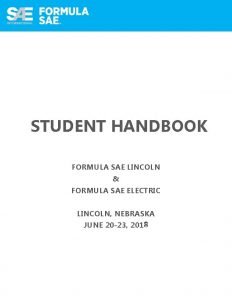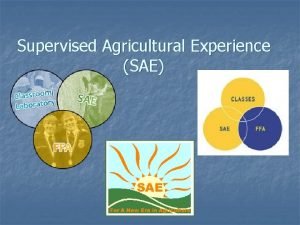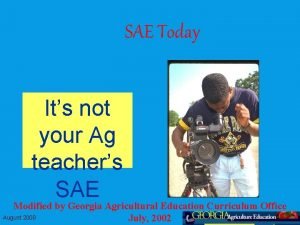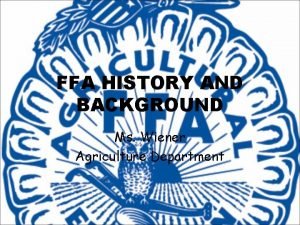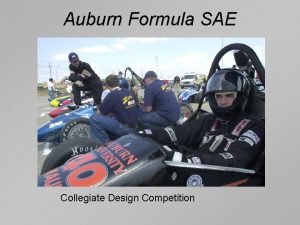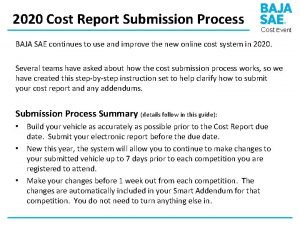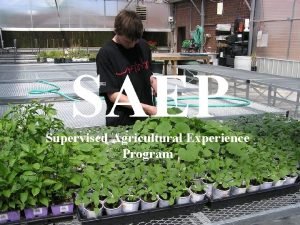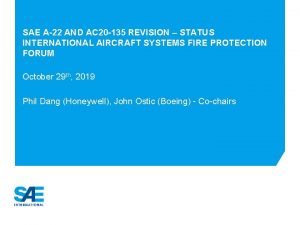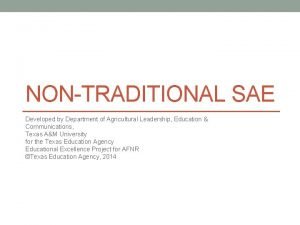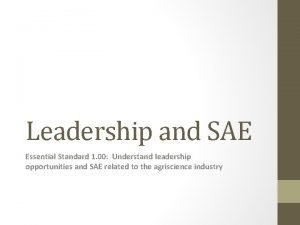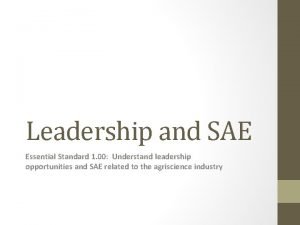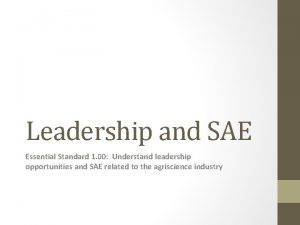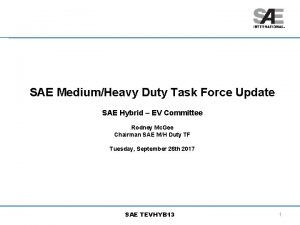Leadership and SAE Essential Standard 1 00 Understand















































































- Slides: 79

Leadership and SAE Essential Standard 1. 00: Understand leadership opportunities and SAE related to the agriscience industry

Objective 1. 01 • Understand the history, opportunities and structure of organizations related to the agriscience industry.

History of the National FFA Organization • 1917 Smith-Hughes Act • established funding • vocational agriculture in high school • 1920’s – Virginia was the first state to have Futures Farmers clubs • Boys only

History of the National FFA Organization • 1928 – FFA became a national organization • A network of teachers guided the establishment of FFA • Effort to establish a club for boys with similar farm interests • 1935 – NFA was formed (New Farmers of America) • Black students studying agriculture

The FFA Creed • History • • Written by E. M. Tiffany Adopted at the 3 rd National FFA Convention in 1930 Revised in 1965 and 1990 Each of the 5 paragraphs begins with “I believe……” • Use • Basic statement of beliefs that helps members understand the importance of FFA • Expresses belief in work ethic, fairness, patriotism, and tradition that all members can share • Requirement for the first degree of FFA membership • Greenhand Degree

Learning the FFA Creed • By ________ you will have to have recited all five paragraphs of the FFA Creed to me. You can set up a time during Power. Hour, the end of class, or afterschool. You may do multiple paragraphs at once or just recite one at a time. • Following the assignment we will have an in class Creed Speaking Competition. The Winner receives 10 points on the next test. Top 3 will get entered into the Chapter Creed Speaking Competition during Power. Hour and get a chance to Represent Central at the regional competition.

2 nd Period- Benchmark • Go to website tinyurl. com/elements 2014 • Type in test ID: 81796514019 • Type in your student ID Number: (lunch Number) • Click Sign In: DO NOT START!!!! Z-Scaler Info: username@cabarrus. k 12. nc. us

History of the National FFA Organization • 1950 – Public Law 740 • FFA became one of a few student organizations to receive a Federal Charter from Congress • 1965 – FFA and NFA merged • 1969 – Girls allowed in FFA for the first time

History of the National FFA Organization • 1988 – Name change • Future Farmers of America to National FFA Organization • Reflects the growing diversity in the agriculture industry • 2012 – National Convention completes 7 year run in Indianapolis • Returned to Louisville, Kentucky in 2013 for 3 years • 50, 000 FFA members attend every year.

FFA Timeline~ Directions: Your assignment is to form a timeline of 12 important dates within the history of FFA and agriculture education. Your timeline should not contain text or written statements. The timeline you make should include a few letters, symbols and numbers but please keep written text to a minimum. In addition please make your timelines: • Have pictures or drawings representing important events in FFA (2 pts each/24 pts) • Fit the entire page (10 pts) • Colorful Neat and Organized ( 10 pts ) • Title and Names (6 pts) Total Points can be earned: 50. Example of a picture timeline:

FFA Mission FFA makes a positive difference in the lives of students by developing their potential for premier leadership, personal growth and career success through agricultural education. • Promotes teamwork, cooperation, and citizenship

Structure of the FFA

National FFA North Carolina FFA Association Southwest Region Gold Mine Federation Central Cabarrus FFA Chapter

FFA Traditions and Ceremonies • FFA Mission Statement – • FFA makes a positive difference in the lives of students by developing their potential for premier leadership, personal growth and career success.

FFA Traditions and Ceremonies • FFA Motto – • Learning to Do, Doing to Learn, Earning to Live, Living to Serve. • FFA Colors – • national blue and corn gold. • FFA Official dress – • white collared shirt, FFA jacket (zipped up), black pants or skirt, black shoes, FFA tie or scarf.

FFA Official Dress • Males • • • Black Socks White Collared Shirt Official FFA Tie Official FFA Jacket zipped to the top Black shoes

FFA Official Dress • Females • Black skirt of appropriate length or Slacks • White Collared Blouse • Official FFA Scarf • Official FFA Jacket zipped to the top • Black shoes

The FFA Official Colors National Blue Corn Gold

National Officer Team • Comprised of six student officers • President • Secretary • Four Vice Presidents

Ryan Best • The current National FFA President. • He is from New Mexico

Dr. Steve Brown • Currently the National FFA Advisor • Employed by the Department of Education

North Carolina State FFA Officers • Made up of six students from across North Carolina • President • Five Vice-Presidents

Southwest Regional FFA Officers • Composed of at least six members from the region • At least one officer is elected from each federation

Central Cabarrus FFA Officers • President • Johanna Hough • Vice President • Austin Arnder • Secretary • Taylor King • Treasurer • Bo Schelling • Reporter • Taylor Turner • Sentinel • Lexie Davis

The FFA Emblem

The Ear of Corn • Provides the foundation of the emblem, just as corn has historically served as the foundation crop of American agriculture. • A symbol of unity, because corn is grown in every state in the nation.

The Eagle • A national symbol which serves as a reminder of our freedom and ability to explore new horizons for the future of agriculture.

The Rising Sun • Signifies progress and holds a promise that tomorrow will bring a new day glowing with opportunity.

The Plow • Signifies labor and tillage of the soil, the backbone of agriculture and the historic foundation of our country’s strength.

The Owl • Long recognized for its wisdom, it symbolizes the knowledge required to be successful in the industry of agriculture.

Words of FFA & Agricultural Education • “Agricultural Education” and “FFA” are emblazoned in the center to signify the combination of learning and leadership necessary for progressive agriculture.

Officer Stations • President sits beside the rising sun and presides over meetings. • Vice President sits beside the plow and calls the roll of officers, coordinates committee work and assumes presidential duties in the absence of the president. • Secretary sits beside the ear of corn and keeps accurate minutes of chapter meetings. . • Treasurer sits beside the emblem of Washington and keeps financial records. • Reporter sits beside the American flag and informs and reports events. • Sentinel welcomes members and guests and assists the president in maintaining order.

FFA Code of Ethics • FFA has established guidelines for member actions and behavior • All FFA members should follow the code and should use it as a guideline to live by. • This class uses the FFA Code of Ethics as its classroom rules.

SAE • Supervised Agricultural Experience • Component used to help students learn to keep records, perform practical job skills, and gain opportunity for work and exploratory experience in Agriscience

Opportunities within the FFA • Career Development Events (CDE’s) • Competitive Events - benefits • Most events progress from the local (chapter) to the federation, regional, state and national level. • Develops technical and leadership skills as well as confidence. • Recognition is received and prize money is often received for 1 st place state finish.

Opportunities within the FFA • Career Development Events (CDE’s) • Animal Science Competitive Events - examples • Dairy Evaluation • grade and evaluate dairy cattle • Poultry Evaluation • grade and evaluate chickens and chicken products • Livestock Judging • grade and evaluate beef cattle, sheep, swine and goats • Horse Judging • evaluate several classes of horses and present oral reasons

Opportunities within the FFA • Career Development Events (CDE’s) • Plant Science Competitive Events - examples • Introduction to Horticulture • knowledge of horticulture and plant identification • Nursery/Landscape • knowledge of the nursery and landscape industry and plant identification • Floriculture • knowledge of floral arrangement , horticulture and plant identification • Forestry • identification of trees and forestry tools as well as measurement of trees

Opportunities within the FFA • Career Development Events (CDE’s) • Leadership Competitive Events - examples • Creed speaking • recitation of the FFA creed. • Prepared Public Speaking • prepare and present a 6 -8 minute speech on an agriculturally related topic of your choice • Extemporaneous Public Speaking • present a 4 -6 minute speech on a topic given to you with 30 minutes preparation time • Parliamentary Procedure • present a mock business meeting • solve business problems and knowledge of business principles

Opportunities within the FFA • Career Development Events (CDE’s) • Agriculture Business Competitive Events - examples • Job Interview • performance of a mock interview for an agriculturally related job • Agricultural Sales • knowledge of sales and marketing • Farm Business Management • solve business problems and knowledge of business principles

Opportunities within the FFA • Career Development Events (CDE’s) • Agriculture Mechanical Competitive Events - examples • Agricultural Tools and Materials • knowledge and identification of tools • Agricultural mechanics • knowledge of agricultural mechanics as well as performance of specific mechanical skills

Pick A CDE out of the Flower Pot • Choose a CDE out of the flower pot. Using the FFA manuals, or your phones, research the following questions about your CDE and be prepared to tell the class about it! • • Name of the CDE Description of the Events you can compete in Who can participate When is the State Competition

Agricultural Organizations related to the Agriscience Industry • Goals • Allow professionals the opportunity to network, learn, and communicate • Provide trade shows and journals • update members on new methods, products, and technology • Uses membership dues • • commodity advertisement trade journals educational programs scholarships for members

Agricultural Organizations related to the Agriscience Industry • Types (examples) • Commodity related • Corn Growers Association (NCGA) • to create and increase opportunities for corn growers • North Carolina Pork Producers Council (NPPC) • promotes and educates a socially responsible and profitable NC pork industry

Agricultural Organizations related to the Agriscience Industry • Types (examples) • North Carolina Nursery and Landscape Association (NCNLA) • flexible, knowledgeable, responsive, environmentally- conscious organization • provides the nursery and landscape industries with leadership, technological and business advancement opportunities and information services • American Quarter Horse Association (AQHA) • world’s largest breed registry and membership organization • North Carolina Christmas Tree Association (NCCTA) • promotes “real” Christmas trees through marketing and education

Agricultural Organizations related to the Agriscience Industry • Other Types (examples) • NC Farm Bureau • unified voice in agricultural issues • offers insurance • provides scholarships and educational opportunities for youth • Carolina Farm Stewardship Assoc. (CFSA) • farm driven, membership based, non-profit, that helps people in the Carolinas grow and eat local, organic foods…… • Grange • is a family–oriented organization • serves its members through a variety of programs and promotes agriculture as an essential industry for our economy • FFA Alumni • open to those who wishes to support students in agricultural education

Agricultural Organizations Research Activity Assignment: Research one of the agricultural organizations listed in the instructional outline and answer questions about the organization. Findings can be reported to the class or turned in to the instructor. • Sample questions to research: • What is the complete mission statement? • What group or groups of people does it serve? • Is it a state or national organization? • What careers are available in the organization? • Have you or your family been involved or directly benefited from this organization?

Objective 1. 02 • Understand effective leadership and communication skills.

Leadership Development in FFA 1. Purpose • Develops confidence, character and citizenship • Builds cooperative attitudes that help students work with others • Encourages the improvement of scholarship

Leadership Development in FFA 2. Ways and Means • Develop an appreciation of FFA traditions • Colors- National Blue and Corn Gold • Program of Activities (POA) • calendar of activities that provides fun opportunities for members, creates a better chapter and provides service to the local community

Leadership Development in FFA 2. Ways and Means continued • Symbols and their meaning: 1. Eagle • National Scope of FFA 2. Plow • Labor and tillage of the soil 3. Owl • Knowledge and wisdom 4. Rising Sun • Progressive nature of agriculture • Need for cooperative effort to reach common goals 5. Ear of corn • Unity • FFA is a national organization with members from across the U. S. and Puerto Rico 6. Lettering “Agricultural Education” and “FFA” • signifies the combination of learning and leadership

Leadership Development in FFA 2. Ways and Means continued: • The FFA Motto: Learning to Do Doing to Learn Earning to Live Living to Serve

Leadership Development in FFA 2. Ways and Means continued • Serving in leadership roles as an FFA Officer 1. President (rising sun) • presides over meetings 2. Vice president (plow) • coordinates all committee work 3. Secretary (ear of corn) • keeps records of all meetings 4. Treasurer (bust of Washington) • keeps financial records 5. Reporter (flag) • public relations 6. Sentinel (hand clasp and shield of friendship) • welcomes guests and visitors

Leadership Development in FFA 2. Ways and Means continued • Other opportunities to develop leadership in FFA • Leaderships schools, camps and conferences (WLC) • Committee involvement (Community service committee) • State and National Conventions • Raleigh, North Carolina in June • Louisville, Kentucky in October • Competitive events

Conducting Business Meetings (Agenda) • Agenda • Call to order by the President • Opening ceremony in FFA meetings • Minutes of the previous meeting • read by the Secretary • approved by the body in accordance to organizational by-laws and parliamentary procedure • reminds members of what occurred at the last meeting • Treasurer reports • Report on Chapter Program of Activities (POA) • presented by officers and committee chairperson • Old Business • New Business • presented by members in the form of motions • Adjournment and closing ceremony • occurs by either passing a motion or by consensus of the body

Conducting Business Meetings (Agenda) • Purpose for an agenda • The agenda keeps the meeting moving forward • The agenda forms the framework for the development of a good meeting

Opening Ceremony Competition • Assignment: Divide students into groups of 7. You will be given practice time to learn to work together. You will be graded based on: • Clarity of Pronunciation (5 pts) • Overall effect (5 pts) • Accuracy (10 pts) • Posture (5 pts)

General Principles of Parliamentary Procedure 1. Extends courtesy to everyone • Members must be recognized to speak • except in cases of emergency or to enforce parliamentary law • Members ask the president for recognition to speak • standing and saying ” Madame/Mr. President” 2. Focuses on one thing at a time • only one motion on the floor at a time • a main motion is presented by saying “I move to/that…”

General Principles of Parliamentary Procedure 3. Observes the rule of the majority • Only main motions that have been seconded can be discussed • Most motions require a simple majority to pass • Action only after the passing of a motion 4. Ensures the rights of the minority • Everyone has the right to voice their opinion during discussion of a motion regardless of which side they may be on • Therefore, a motion to stop discussion requires a 2/3 vote to pass • 20 out of 30 would have to vote to end discussion

Main Motion • Introduce new business 1. Address the presiding officer 2. Receive recognition to speak 3. State the motion • “I move that our FFA chapter conduct a community service project. ” 4. 5. 6. 7. • • Someone seconds the motion Discussed by the group Vote Chair announces result of vote Requires a second Debatable Amendable Majority vote required

Amendment • Alter or change a motion • adding • striking out • Substituting • • Requires a second Debatable Amendable Majority vote required

Refer to a Committee • To put the motion in the hands of a small group • “I move to refer this motion to a committee of three people appointed by the chair, who will report back at the next regular meeting” • • Requires a second Debatable Amendable Majority vote required

Previous Question • Introduce new business • “I move the Previous Question. ” • • Requires a second Not Debatable Not Amendable 2/3 Majority vote required

Suspend the Rules • Allow the chapter to act in a way that would be against the rules of parliamentary law. • “I move to suspend the rules and waive the reading of the minutes. ” • • Requires a second Not Debatable Not Amendable 2/3 Majority vote required

Point of Order • Enforces the rules of parliamentary law. • “I rise to a Point of Order. ” • • No second required Not Debatable Not Amendable No vote taken

Adjourn • Ends the meeting • “I move to adjourn. ” • • Second required Not Debatable Not Amendable Majority vote required

Voting • Common methods 1. Voice vote • by saying “aye” or “no” 2. Rising vote • Standing • show of hands 3. Secret ballot • written vote 4. Roll call • each member speaking their vote when the secretary calls their name

Gavel • Taps are used to signal members of action they should take or to signal the completion of a parliamentary action • One tap • follows announcement of adjournment • follows the completion of a business item • to be seated • Two taps • signal the official start of the meeting and calls the meeting to order • Three taps • are used to signal all members to stand • members are to rise in unison at the third tap of the gavel

Preform a Business Meeting… • As a class we are going to practice preforming parliamentary procedure and elect officer.

Public Speaking • Oral communication skills are one of the most important factors in determining career success • The FFA Creed • gives students the opportunity to develop basic public speaking skills • helps to develop confidence • Oral communication can be improved through practice (and more practice) • Practice improves the speaker stage presence • • Attitude Confidence Personality Ease before the audience Personal appearance Poise Posture

Objective 1. 03 • Understand the importance of SAE to work-based learning.

SAE – What is it? 1. An individualized project • Supervised Agricultural Experience • Conducted outside of the regularly scheduled school day 2. Makes up the third part in a total agricultural education program • Classroom /laboratory instruction • FFA • SAE 3. SAE is for every student • A percent of your course grade

Purpose of SAE • • • Opportunities to explore a variety of subjects Educational and practical experience in a specialized area Opportunities for earning while learning Teaches accurate computerized or written records Win FFA awards • FFA proficiency awards

Types of SAE • Exploratory • Short duration usually • Students become more literate in agriculture • Develop awareness of agricultural careers • Examples: • • • Observing and/or assisting a veterinarian Interviewing a landscape contractor Shadowing a greenhouse employee Observing/assisting a welder Attending a career day/fair

Types of SAE • Entrepreneurship • Ownership or part-ownership • assume financial risk • Skills necessary to become established in one’s own business • Types of Entrepreneurship • Production SAE • Raise and sell an agricultural commodity for profit • Examples: produce vegetables, grow Christmas trees, raise livestock, dogs, or horses, grow field or nursery crops. • Agribusiness SAE • Students own and operate an agricultural related business • Examples: lawn maintenance or landscaping business, crop scouting service, pet sitting service, feed sales, computer service for farms, horse riding lessons

Types of SAE • Placement • Students obtain a job with an employer • often with the help of their instructor • Typically paid an hourly wage • Examples: • Placement in Production • on a farm • greenhouse • nursery or other production facility • Placement in Agribusiness • • work at a veterinary clinic florist feed store landscaping business

Types of SAE • Improvement • Activities are done to improve the appearance, convenience, efficiency, safety or value of a home, farm or other facility. • No wages earned • No ownership necessary • Examples: • • • landscape parent or grandparent’s home building a fence building a storage shed growing herbs or vegetables in containers on a porch or patio assist with landscape maintenance at an apartment complex

Types of SAE • Analytical • Students choose an agricultural problem not easily tested by experimentation • Gather and evaluate data • Non-experimental • Examples: • Develop marketing plan for poinsettia crop • Research and present project on effects of temperature change on corn yields in South America

Types of SAE • Experimental • Students conduct and an agriculturally related experiment • Scientific method • Examples: • Compare the effects of various rates of nitrogen on poinsettias • Compare the effects of various feeds on average daily gain in lambs • Can be used to compete in the State Agriscience Fair.

Types of SAE • Supplementary • Activities are short-term activities with little or no planning involved • Skill specific, non- wage earning • Examples: • • • learning to prune peach or apple trees changing hydraulic fluid in a tractor mowing a baseball infield or putting green trimming sheep feet bottle feeding dairy calves
 To understand recursion you must understand recursion
To understand recursion you must understand recursion Unit 650 leadership and management
Unit 650 leadership and management Characteristics of lipids
Characteristics of lipids Sae standard for hoist location
Sae standard for hoist location Transactional vs transformational leadership
Transactional vs transformational leadership Adaptive leadership vs situational leadership
Adaptive leadership vs situational leadership Enthusiastic beginner disillusioned learner
Enthusiastic beginner disillusioned learner Standard deviation and standard error
Standard deviation and standard error Home language
Home language Standard costing is
Standard costing is Murid berkeperluan khas berkefungsian rendah
Murid berkeperluan khas berkefungsian rendah Sae baja rack and pinon
Sae baja rack and pinon Sae baja rack and pinon
Sae baja rack and pinon Rack and pinion baja sae
Rack and pinion baja sae Blue and gold basics sae programs
Blue and gold basics sae programs History contributes to moral understanding.
History contributes to moral understanding. Understand quran and salah the easy way
Understand quran and salah the easy way Understand quran and salah the easy way pdf
Understand quran and salah the easy way pdf Qualitative vs quantitative variable
Qualitative vs quantitative variable Timeline bc ad
Timeline bc ad Understand quran and salah the easy way
Understand quran and salah the easy way Quran for beginners lesson 1
Quran for beginners lesson 1 Www.understand quran and salah
Www.understand quran and salah Www.understand quran and salah
Www.understand quran and salah How to understand and apply the old testament
How to understand and apply the old testament What does it mean to be a critical reader
What does it mean to be a critical reader Quran for beginners lesson 4
Quran for beginners lesson 4 Can a real number be both rational and irrational
Can a real number be both rational and irrational 7 rational or irrational
7 rational or irrational And understand
And understand Creating and interpreting graphs and tables
Creating and interpreting graphs and tables What is an sae
What is an sae Sae unh
Sae unh Supplementary sae examples
Supplementary sae examples Exploratory sae
Exploratory sae Sae tech zone
Sae tech zone Sae gw lte
Sae gw lte Sae j2579
Sae j2579 My tech zone sae
My tech zone sae Safety data reconciliation
Safety data reconciliation Sae j3138
Sae j3138 Sae j3161/1
Sae j3161/1 Sae recommended practice
Sae recommended practice Sae j 2464
Sae j 2464 Arp 4761
Arp 4761 Research sae definition
Research sae definition Bulk current injection testing
Bulk current injection testing The sae term for the vehicle computer is
The sae term for the vehicle computer is Sae lse
Sae lse Sae s-18
Sae s-18 Problem statement formula
Problem statement formula Entrepreneur sae
Entrepreneur sae University of canada
University of canada Amigos / kings classic menu
Amigos / kings classic menu Sae j3068
Sae j3068 Formula sae electric
Formula sae electric Sae control pattern
Sae control pattern Sae ndsu
Sae ndsu Essnet sae
Essnet sae Sae government industry meeting 2019
Sae government industry meeting 2019 Sae my tech zone
Sae my tech zone What type of sae is when you own your own business
What type of sae is when you own your own business Directed school laboratory sae
Directed school laboratory sae Baja sae braking system
Baja sae braking system Explore sae.com
Explore sae.com Sae international conference
Sae international conference Sae pri
Sae pri Säkeistö ja säe
Säkeistö ja säe Sae digital simulado
Sae digital simulado Sae programs worksheet
Sae programs worksheet Ffa history crossword puzzle answers
Ffa history crossword puzzle answers Tea cup england
Tea cup england Sae auburn
Sae auburn Sae j 2579
Sae j 2579 Baja sae cost report 2020
Baja sae cost report 2020 Ownership/entrepreneurship sae examples
Ownership/entrepreneurship sae examples Ac20-135
Ac20-135 Sae a-22
Sae a-22 Non traditional sae projects
Non traditional sae projects Research sae examples
Research sae examples












